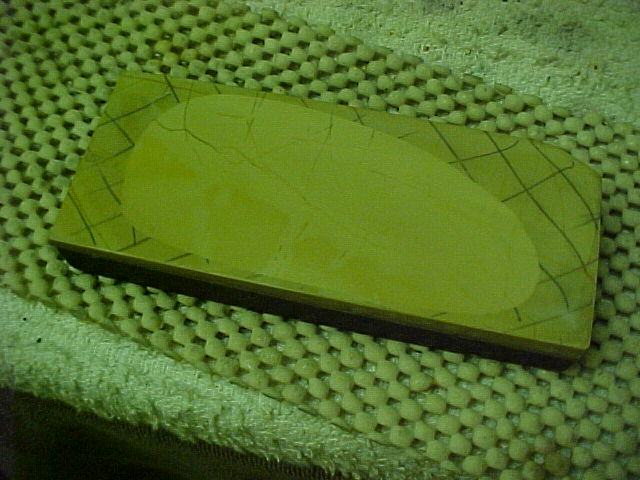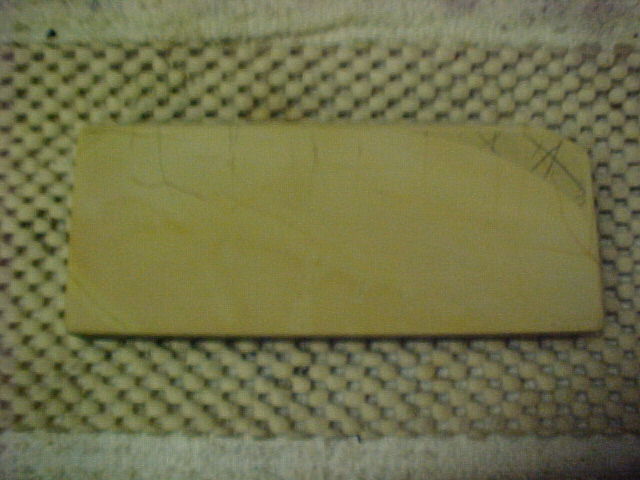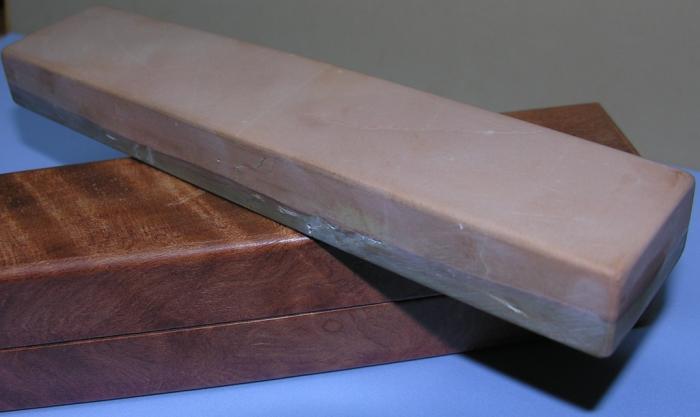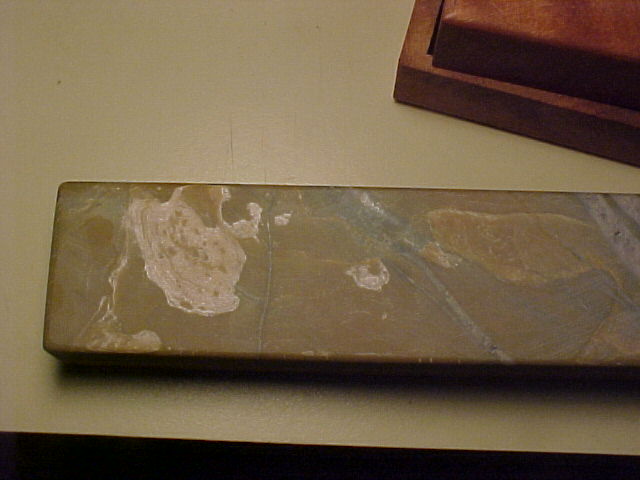Results 11 to 20 of 62
Thread: Toxic hones...
-
12-07-2016, 03:14 PM #11< Banned User >

- Join Date
- Oct 2016
- Location
- Saratoga, CA
- Posts
- 597
Thanked: 59
When you buy from reputable sources you generally don't need to be worried about it unless it got past them. Any type of line or dot can be toxic or not. Sometimes toxicities can show up on a stone that has been fine in the past. Try to get a guarantee when you buy a stone on toxic inclusions. Toxicities can range from a stone that is acidic to sand particles. An acidic stone will most of the time have a slightly sour sulfuric smell to it and can turn a blade black in a matter of minutes and a sand particle will grab a chunk of steel out of your fresh bevel while your making laps.
Last edited by Aerdvaark; 12-07-2016 at 03:28 PM.
-
The Following User Says Thank You to Aerdvaark For This Useful Post:
aaron1234 (12-07-2016)
-
12-07-2016, 03:43 PM #12Senior Member

- Join Date
- Sep 2015
- Posts
- 695
Thanked: 77
That true but most of mine are flee market finds....
Sent from my SAMSUNG-SM-G935A using Tapatalk
-
12-07-2016, 08:27 PM #13
-
The Following User Says Thank You to Kees For This Useful Post:
aaron1234 (12-07-2016)
-
12-07-2016, 08:49 PM #14

Re:Toxic/acidic hones. I have a Thuringen size and type that is great hone...but...will darken steel in short order. I do as the Japanese, I make my spray bottle water "basic" by adding baking soda. Not necessary to change the water for other hones.
YMMV~Richard
-
The Following 2 Users Say Thank You to Geezer For This Useful Post:
Aerdvaark (12-07-2016), Toroblanco (05-27-2017)
-
12-08-2016, 04:21 PM #15

Toxic Features and Solutions for Jnats
Regular cracks (vertical or nearly vertical to the honing surface) are usually not toxic. Any sharp edged defect or depression can shed particles, so I dress those edges with a fiberglass brush after lapping, the raise a thick slurry to further erode any unstable material. Use the ends of the bristles against the corners of the crack.
Bias cracks are cracks that intersect the honing surface at a shallow angle. These can be non-toxic or toxic. Their toxicity comes from the very thin edge shedding particles under pressure from the nagura or razor. The solution is to dress them with a fiberglass brush to remove unstable material. You’ll have a low line in the hone, but it will not be toxic.
Glassy lines or spots are mineral lines/spots that are filled with glassy silica. Usually toxic ones never make it to the market, but stones can erode down into one. Glassy lines etc are only toxic if they are strong enough to resist eroding along with the rest of the stone, so most of them are not toxic. Sometimes only part of a line is toxic. You can feel them standing proud with a light rub of the fingertip.
Glassy lines are first picked with a carbide scribe. Note that you do not necessarily have to completely remove the feature, just destabilize it. You push straight down on the glassy feature and make a small dimple. Repeat this process until you have a series of touching dimples all along the toxic feature. Then VERY lightly drag the scribe vertically along the dimples to remove any unstable material between the dimples. Then drag the scribe VERY lightly at a 45-degree angle to each corner of the line you now have to remove any unstable material at the edges of the line. Then dress the line with a fiberglass brush and slurry the stone. You’re done until you lap again. Note: If you try to drag the scribe linearly along the line to begin with, you will end up with an unsightly mess that may not work well.
Suita can have sandy pockets or lines, sand-filled vugs or depressions, you just remove the sand with a fiberglass brush or scribe, whatever works best, then stabilize the corners with a fiberglass brush.
Scratchy goma - this is the black pepper specks that shine when burnished by steel. They’re mostly silica I believe though they appear black. Some of them may resist wear and scratch steel. Nothing to do here, there are usually too many of them to fix.
Use caution and light pressure with fiberglass brushes - they can gouge stones and scratch steel.
Cheers, Steve
-
The Following 6 Users Say Thank You to Steve56 For This Useful Post:
Aerdvaark (12-08-2016), AnsichtskarteausSolingen (12-20-2016), Euclid440 (12-08-2016), Grazor (12-08-2016), strangedata (12-09-2016), Toroblanco (05-27-2017)
-
12-08-2016, 04:23 PM #16

A fiberglass brush image and glassy lines so bad they can tear up a kitchen knife. And a small bias crack.
Cheers, SteveLast edited by Steve56; 12-08-2016 at 04:29 PM.
-
The Following 5 Users Say Thank You to Steve56 For This Useful Post:
aaron1234 (12-08-2016), Aerdvaark (12-08-2016), Geezer (12-08-2016), RusenBG (12-14-2016), strangedata (12-09-2016)
-
12-08-2016, 05:17 PM #17

Of course some inclusions are not an issue. I had an old coticule, that belonged to a pro barber, that had a large inclusion kind of spider webbed through the yellow. When I got it I was leery that it might be a problem, though it was dished from use. Turned out it didn't affect the edge. Not sure if you can see the inclusions, but from the grid you can see how dished it was after a few swipes on the plate.
Attachment 251605Attachment 251606Attachment 251607

Another coticule which turned out to be a hybrid, before the genre became known through Ardennes, had some of the same inclusions in the hybrid side. Typical of that hybrid side it was very hard. More of a polisher than a cutter.

 Be careful how you treat people on your way up, you may meet them again on your way back down.
Be careful how you treat people on your way up, you may meet them again on your way back down.
-
The Following 2 Users Say Thank You to JimmyHAD For This Useful Post:
Hirlau (12-08-2016), strangedata (12-09-2016)
-
12-08-2016, 05:31 PM #18Senior Member



- Join Date
- Apr 2012
- Location
- Diamond Bar, CA
- Posts
- 6,553
Thanked: 3215
Are you filling the voids, if so with what?
CA?
-
12-08-2016, 05:50 PM #19< Banned User >

- Join Date
- Oct 2016
- Location
- Saratoga, CA
- Posts
- 597
Thanked: 59
Never even knew there was such a tool as a fiberglass brush. Just ordered that and a carbide scribe.
Great information!!
Thanks again!!
-
12-08-2016, 06:00 PM #20
-
The Following 2 Users Say Thank You to Steve56 For This Useful Post:
Euclid440 (12-08-2016), strangedata (12-09-2016)


 99Likes
99Likes LinkBack URL
LinkBack URL About LinkBacks
About LinkBacks






 Reply With Quote
Reply With Quote


